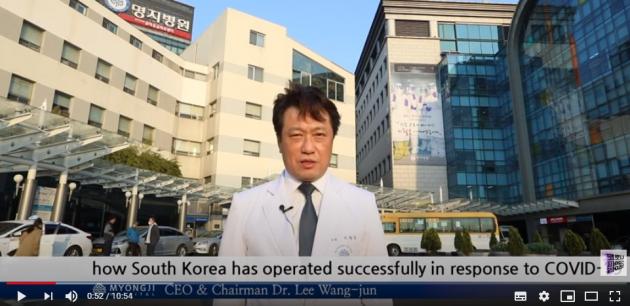Myongji Hospital, designated by the government as a control hospital for infectious diseases and disasters in 2014, has been at the center of Korea’s effective and fast response to the new coronavirus (COVID-19) outbreak.
Immediately after Korea reported the first case of COVID-19 on Jan. 20, the hospital in Goyang, Gyeonggi Province, just north of Seoul, started to prepare the battle against the then-rarely known disease.
“Since the third patient with COVID-19 in Korea was transferred to our hospital, we started the big battle, not against the virus itself but the fear and phobia about COVID-19,” said Lee Wang-jun, chairman of Myongji Hospital, who also leads the Korea Hospital Association’s COVID-19 Emergency Response Committee, on a YouTube video.
In the video, he introduced Korea’s four strategies against COVID-19 and Myongji Hospital’s detailed responses.

As of April 6, Korea reported 10,284 confirmed cases, 6,598 recovered cases, and 186 deaths.
Lee noted that Korea was able to flatten the epidemiologic curve thanks to four strategies – transparency in communication, using containment and mitigation policies together, having multi-tiered triage and treatment system, and extensive screening and fast-tracking.
Myongji Hospital has 12 negative pressure isolated rooms -- five at intensive care units (ICU), three at emergency centers, and four in the general ward.
Lee said the hospital operated two tiers of separate screening centers to maintain the hospital’s capacity in control. The emergency department-based screening center focused more on highly suspected COVID-19 patients with symptoms, while the outpatient department-based screening center focused on simple flu-like illnesses.
Myongji Hospital’s Block E building was specifically designed for emergency care and infection control, with the first floor having three negative pressure rooms and screening centers. The second and fifth floors are designated for treating COVID-19 patients.
The hospital temporarily changed a general ward on the third floor into Pneumonia Surveillance Unit to concentrate on pneumonia patients and modified another general ward on the fourth floor to Admission Screening Unit, Lee explained.
“We wanted to make sure to check every single hospitalized patient by PCR (polymerase chain reaction) test before their admission. Only after we confirm the negative results, can the patients be moved to the general ward,” Lee said.
The hospital has treated 34 confirmed patients for the past 10 weeks since it started the battle against COVID-19, he added.
Aside from treating patients, Myongji Hospital has carried out four additional projects, Lee went on to say.
The first was publishing a case report of the third confirmed patient who later became the first to be infected by a tertiary transmission outside of China, on the Journal of Korean Medical Science.
The second was developing the COVID-19 reverse-transcription polymerase chain reaction (RT-PCR) testing kit in partnership with Cancer Rop, a biotech subsidiary of Myongji Hospital. The kit has obtained regulatory approval for export and is waiting for the U.S. Food and Drug Administration’s approval for emergency use.
The third was a collaboration with an AI solution developer to diagnose COVID-19 using chest CT.
The fourth and last one is psychological support for isolated COVID-19 patients.
“As you know, the isolated situation itself is very desperate and deteriorative. Most patients need both psychiatric consulting and psychological help. That is why we organized the bedside concert to support the patients hosted by our art-healing center,” Lee said.

